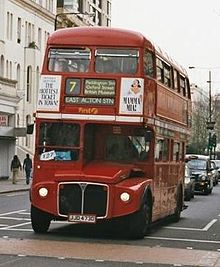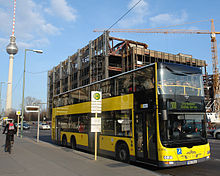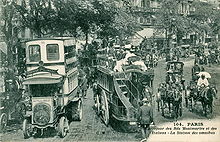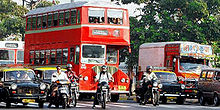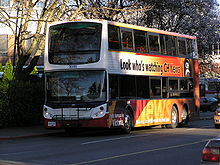
Double-decker bus
About this schools Wikipedia selection
This selection is made for schools by a children's charity read more. To compare sponsorship charities this is the best sponsorship link.
A double-decker bus is a bus that has two storeys or decks. Red double-decker buses are used for mass transit in London. Double-decker buses are also used in other cities in Europe, Asia, and former British colonies and protectorates such as Hong Kong and Singapore.
Almost all double-deckers have a single, rigid chassis.
This type of bus is often used for touring rather than for mass transit. As William Ewart Gladstone observed, "...the way to see London is from the top of a 'bus". (Gladstone was referring to London's once ubiquitous double-deck horse drawn omnibuses, rather than a motor bus).
By country
Cities listed here use double-decker buses as part of their regular mass transit fleet. Cities with only tourist and sightseeing double-decker buses are excluded.
Europe
United Kingdom
Double-decker buses are in common use throughout the United Kingdom, and have been favoured over articulated buses by many operators because of the shorter length of double-deckers, and less need to have standing capacity. The majority of double-decker buses in the UK are between 9.5 metres (31 ft 2 in) and 11.0 metres (36 ft 1 in) long, the latter being more common since the mid-1990s, though there are three- axle 12 metres (40 foot) models in service with some operators. Double-decker coaches in the UK have traditionally been 12.0 metres in length, though many newer models are about 13.75 metres (45 ft 1 in). The maximum permissible length of a rigid double-decker bus and coach in the UK is 15.0 metres (49 ft 3 in), and although there are no theoretical restrictions on height, coaches are normally built to 4.38 metres (14 ft 4 in) high, while 'highbridge' buses are normally about 20 centimetres (8 in) taller. Articulated double-deckers are also allowed at a maximum length of 18.75 metres (61 ft 6 in).
In 1941, Miss Phyllis Thompson became the first woman licensed to drive a double-deck vehicle in England. She drove for the bus company Messrs. Felix Motors Ltd, then at Hatfield near Doncaster.
The red double-decker buses in London have become a national symbol of England and British Isles. The majority of buses in London are double-deckers. Right after the Second World War the first double-decker buses were the AEC Regent II and AEC Regent III models. A particularly iconic example was the Routemaster bus, which had been a staple of the public transport network in London for nearly half a century following its introduction in 1956. Because of cited difficulties accommodating disabled passengers, the last remaining examples in use finally retired in 2005, although Transport for London has established two "heritage routes", which will continue using Routemasters on selected parts of routes 9 and 15. Since 2008, a new Routemaster has been developed and entered service on 20 February 2012, in time for the 2012 Summer Olympics. Since Boris Johnson won the 2nd term in May. The first batch of production buses will enter into service in Spring 2013.
In 2007, a hybrid-powered double-decker entered service on London Buses route 141. From late 2008, more hybrid double-deckers from three manufacturers entered service in London.
Republic of Ireland
In the Republic of Ireland, the majority of buses operated in and around Greater Dublin by Dublin Bus are double-deckers. There are 1,125 double-decker buses (second after London) in the company's fleet of 1,199.
The Bus Éireann company also utilises double-decker buses on some of its short-haul routes, such as the Dublin to Dundalk service. Double-deckers are also common on some of the company's suburban routes in Cork city.
Germany
In Germany, double-decker buses in Berlin are operated by Berliner Verkehrsbetriebe (BVG). The fleet of double-decker buses in Berlin fell from 1,000 in 1992 to 450 in 2002. The models in operation in 2002 were 13.5 metres (44 ft 3 in) long and held around 95 passengers. The replacements, which are supplied by Neoman Bus, are 1.8 metres (5 ft 11 in) longer. The new buses are able to hold 128 passengers.
Macedonia
The Macedonian government bought 220 double-decker city buses for local transport in Skopje, the capital. The first shipment of 68 custom-made buses arrived in Skopje in 2011 from China’s Zhengzhou Yutong factory. The buses were put into operation on 8 September, coinciding with the day of Macedonian independence. This model of bus have capacity for 80 passengers.
Turkey
In Turkey, the Istanbul public transit system ( IETT) runs 89 double-decker buses on longer-distance routes, most notably commuter buses crossing the Bosphorus Bridge linking the European and the Asian sides of the city. Double-decker buses are also used on routes to and from Taksim Square to far-flung western suburbs such as Büyükçekmece and Bahcesehir.
France
The first double-decker bus was invented in Paris in 1853, it was an horse-drawn omnibus. The upper floor was cheaper and often uncovered.
The first double-decker motor bus in Paris, Schneider Brillié P2, appeared in 1906. It was designed to allow more passengers and to replace the horse-drawn double-decker omnibus. Like trams and omnibuses, double-decker motor buses include several classes: the first, inside the car and the second class on the deck outdoors. But this type of vehicle disappeared in 1911 because one of these buses overturned at place de l'Étoile, following this incident the P2 lost their imperial and were renamed P3.
It's not until 1966 that the RATP retried the experience of double-decker bus on two lines in Paris. A prototype built by Berliet (type E-PCMR), was put in service in 1966. An order was placed for 25 vehicles. The commissioning of the first production car was effective on June 19, 1968 on line 94, Gare Montparnasse - Levallois. The February 17, 1969, line 53, Opera - Porte d'Asnieres, in turn, was equipped with this model. But the traffic problems make it definitively abandon this vehicle in 1977, because this type of bus is poorly suited to the structure of the Paris network, the stops being too close to each other which prevented people from going upstairs. Since, there are no Parisian mass transit lines using double-decker buses.
Africa
Egypt
Double decker buses are used in Alexandria, Egypt
Asia
Sri Lanka
In the 1950s, double-decker buses of the South Western Bus Company plied on the Galle Road in Colombo, Sri Lanka. These were taken over by the Ceylon Transport Board (CTB) when all bus services were nationalised in 1958. Beginning around 1959, large numbers of second-hand double-decker buses of the RT, RTL and RTW classes were imported by the CTB from London Transport, and ran in their original red livery with the oval CTB logo painted on the sides. These buses were phased out beginning in the mid-1970s, and none remain in service. Later, around 1985, 40 ex-London Routemaster entered service. One Routemaster bus is run by the Sirasa TV and radio station.
Today's buses in Sri Lanka include Routemaster (Currently phased out in order to make way for Volvo B9TL/East Lancs Nordic and incoming First Western Dennis Trident 2/Plaxton President - 2001/02), MCW Metrobus (including 12m parts), Leyland Atlantean, and Dennis Trident 2 (1999/2000), plus some of the Volvo B7TL/East Lancs Vyking and Volvo B9TL/East Lancs Nordic buses.
Singapore
In October 1953, a single AEC Regent III double-decker from the fleet of General Transport Company, Kuala Lumpur (KL), was sent to Singapore for demonstration. It was used on service by the Singapore Traction Company for two weeks. After that, it was inspected by two other bus companies, and then sent back to KL. However, no orders for double-deckers immediately followed.
Singapore Bus Service (SBS, now known as SBS Transit), the only large-scale operator of double-decker buses in Singapore, launched their first double-decker bus service on 13 June 1977 with 20 Leyland Atlanteans. The fleet grew steadily, with the further introduction of the Mercedes-Benz O305 and the Leyland Olympian. The Leyland Olympian, the first air-conditioned double-decker bus, named the "Superbus" in recognition of its record-breaking 12 metres (40 foot) length, was launched in 1993. The Volvo B10TL, the first stepless, ultra low floor "Superbus" was launched in 1999. Volvo B9TL wheelchair accessible buses began to be introduced in 2006. SBS Transit has a fleet of over 900 double-decker buses, most of which are air-conditioned.
Japan
By Japanese law, vehicles are confined to maximum 3.8 metres (12 ft 6 in) height and 12.0 metres (39 ft 4 in) length. Japanese double-decker buses are mainly used for inter-city highway buses (i.e., motor coaches), city tours, and charter buses. In 1960, Kinki Sharyo and Hino Motors manufactured the first original double-decker bus "Vista Coach" for Kinki Nippon Railway (Kintetsu).
In 1979, Chuo Kotsu, a chartered bus operator in Osaka, imported the Neoplan Skyliner. Skyliner, and the other imported buses: Van Hool Astromega TD824, Drögmöller E440 Meteor, and a few MAN coaches inspired Japanese bus manufactures, who developed three domestic models in the mid-1980s: " Nissan Diesel Space Dream", " Hino Grand View" and " Mitsubishi Fuso Aero King". They did not, however, sell very well as the ceiling was only 1.7 metres (5 ft 7 in) high. Nevertheless, Aero King was sold for 22 years, but, being unable to meet exhaust gas emission and safety levels, production stopped in 2005.
In 1982, Toei Bus operated Skyliners in Tokyo, between Asakusa and Ueno to 2001. Joban Kotsu operated Skyliners in a trans-Fukushima route: between Iwaki and Aizu-Wakamatsu via Koriyama from 1983 to 1996.
Since the 1990s, JR Buses started to use Aero King for an overnight inter-city highway bus service named "Dream-go". The first Aero King in Dream-go, operated to "Fuku Fuku Tokyo" between Tokyo and Shimonoseki, Yamaguchi with Sanden Kotsu, which was replaced with a "super high-decker" coach in middle of the 1990s, "Fuku Fuku Tokyo," and finally stopped in 2006.
Japanese overnight highway buses are mainly equipped with a three-line, two-aisle (1+1+1) seat configuration with reclining seats. When this configuration is used on an ordinary coach, it has 28, 29 or 31 seats. When this configuration is used on a double-decker bus, it has 36 or 40 seats: the vehicle's price and capacity increase while operating cost decreases.
JR Bus group mainly uses Aero King, Skyliner, and a few Jonckheere Monaco (equipped with Nissan Diesel engine) for inter-city highway bus operations between Kanto (near Tokyo) and Kansai (near Osaka), which is named "Dream-go" (overnight express) and "Hiru-tokkyu" (Daytime Express). The other bus operators, inspired by "Dream-go", increased use of the Aero King for overnight inter-city bus service.
JR Bus Kanto imported four Neoplan Megaliner N128/4, leasing two to an operating partner (from 2003 to 2006, Kanto Railway, since 2006 Nishinihon JR Bus). The Megaliner is 15.0 metres (49 ft 3 in) long, and has 84 seats (with 2+2 configuration), and is operated on an inter-city highway route between Tokyo and Tsukuba, Ibaraki from 2002 to 2005. The Megaliner has also been converted for a low-price overnight highway bus service between Tokyo and Osaka called "Seishun Mega Dream-go," with special authorisation.
Hong Kong
Double-decker buses were first introduced in Hong Kong in 1949 by Kowloon Motor Bus. They have become very popular since then, and they are found in large numbers among the fleets of the territory's major bus operators (see below). By law, double-decker buses in Hong Kong are limited to a length of 12 metres (40 feet). Today, the majority of buses running in Hong Kong are double-decker buses, and all of them are air-conditioned. Also, Hong Kong has a double-deck trams system, currently one of three only and most famous in the world.
Macau
Fok Lei and its successor Transmac of Macau used second-hand double-deckers widely from early 1970s until late 1980s.
Mainland China
Several cities in continental China have double-deckers in regular use on certain crowded lines, while some have a few double-deck buses in use on lines which also use single-deck vehicles, e.g. Nanning on line #704 in peak hours. Besides Nanning, Beijing, Shanghai, Guangzhou, Shenzhen, Tianjin, Hangzhou, Wuhan, Dalian, and Kunming also have those buses in service, particularly on routes during rush hours. Larger towns in the developed coastal provinces, including Shaoxing, Zhejiang province, use double-decker buses.
India
In India, Bangalore had Double Decker's for a while before discontinuing. Madras's Metropolitan Transport Corporation (MTC) has a small fleet of double-decker buses mostly in the high-density, longer distance routes. Mumbai has operated double-decker buses since 1937. They are operated by the Brihanmumbai Electric Supply and Transport undertaking. Thiruvananthapuram, Kochi, Kolkata and Hyderabad also have double-decker buses. They are modelled on the London buses. Ashok Leyland Titan double decker buses are used in all cities. Articulated double decker buses from Ashok Leyland were used till it was phased out in early 1990s and Volvo B9TL Wrights are now began operating in Mumbai and Chennai since early 2010 and Enviro400s were also brought into Hyderabad since 2011.
Indonesia
In Indonesia, double-decker buses currently operating only in Surakarta However it isn't targeted for public but tourists.
Russia

Double-decker buses in Russia are currently operated in Asian city of Barnaul, capital of Altai. The fleet of double-decker buses in Barnaul consist of MAN SD200 and MAN SD 202 buses imported from Berlin. Those buses are in use on routes 3, 10 and 17. Some cities in Russia, including Moscow and Saint-Petersburg, plan to begin operating of double-decker buses; in the mid-1990s, some double-deckers have been used in St. Petersburg for a short time.
North America
Canada
In 2000, Victoria and Kelowna, British Columbia, Canada became the first cities in North America to use modern double-decker buses in their public transit systems. These buses were imported from the United Kingdom and operated by BC Transit, Victoria Regional Transit System and Kelowna Regional Transit System; they have proven to be very popular amongst both locals and tourists. In Victoria, the buses are mainly used on routes that go from downtown to the suburbs, and to the Swartz Bay Ferry Terminal near Sidney, B.C. They can also be found on routes that head to the University of Victoria and the Western Communities. In December 2007, Chairman of the Victoria Regional Transit Commission, Don Amos, announced the purchase of 16 new double-decker buses for the region, worth an estimated $12.8 million CDN. The buses entered service in the summer of 2008.
In July 2006 and February 2007, double-decker buses similar to those in Victoria were being tested in Ottawa, Ontario. OC Transpo, the transit system that operates in Ottawa, has purchased three of these buses. They were delivered in November 2008. Since March 2009, they have been in service across the city of Ottawa. On April 20, 2011, the purchase of an additional 75 double-decker buses was approved and they are expected to enter service on express routes starting in late spring 2012.
GO Transit in Toronto, Ontario started operating 12 Alexander Dennis Enviro500 double-decker buses in 2008, with 10 more entering service in 2009.
Strathcona County started a year-long double-decker pilot project in September 2010. Strathcona County Transit is exploring different high-capacity bus types to carry more passengers on the high-demand commuter routes, which are between Strathcona County and Edmonton; an articulated bus is also being evaluated as an alternative. The single double-decker bus used for the evaluation is a fully accessible, low-floor transit bus featuring high-backed seats; it can seat 66 passengers, with capacity for a further 18 passengers to stand (on only the lower level, due to the lack of headroom on the upper level). It is an Alexander Dennis Enviro500 and is on a one-year lease from the manufacturer. It is the first double-decker to be used for regular transit service in Alberta.
United States
In Davis, California, Unitrans, the student-run bus company of University of California, Davis, operates six double-decker buses imported from London. One of these buses has been converted to run on compressed natural gas (CNG) . There was also the prototype GX-1 Scenicruiser of Greyhound Lines, which enters from the first floor: the second floor contains the driver's compartment and more seats.
Citizens Area Transit, the transit authority in the Las Vegas, Nevada area, introduced a fleet of double-deckers to serve the Las Vegas Strip route in October 2005. The route is branded as " The Deuce". As of 2009 it serviced eight lines.
In Snohomish County, Washington, Community Transit operates one Alexander Dennis Enviro500 double-decker bus as a demonstrator, which rotates among commuter routes between Snohomish County and Seattle. A fleet of 23 such buses have been purchased for service beginning 2010.
In San Luis Obispo, California, SLO Transit tested a double-decker bus in late 2008 to see if it would alleviate the over-crowdedness of Route 4. The borrowed bus has been returned, and SLO Transit has purchased one double-decker bus of its own using a combination of Federal, State and local funding. The bus went into operation on September 8, 2010.
In Los Angeles County, California, the Antelope Valley Transit Authority uses double-decker buses as part of its commuter service to the Los Angeles area.
Also in Los Angeles, SCRTD used Neoplan AN 122/3 Skyliners double-decker buses from the late 70s until 1993.
In San Francisco, California, the San Francisco Municipal Transportation Agency operated one Alexander Dennis double decker bus as a demonstrator between December 12, 2007 and January 8, 2008. The bus was running on some high capacity routes as trial.
Also, in the United States, a private operator, Megabus, run by Coach USA, employs double-decker buses on its busier intercity routes.
Finally, starting in 2013 Stallion Bus will start distributing open top and closed top double deck buses to the United States and Canada
Oceania
New Zealand
While double-decker buses have been present in New Zealand for many years, they have so far only been used by tour operators and as a long distance coach service between Auckland and Wellington (operated by Intercity Coachlines) and have not been utilized in the day to day operation of public transport in New Zealand since the 1970s.
A single double-decker bus arrived in Auckland in early March 2013 for a trial, with more double-decker buses planned to arrive in 2014 should the trial prove successful. The Scania K320 bus, operated by Ritchies Coachlines, will begin operating in revenue service on 11 March 2013 on the well-patronised Northern Express (NEX) route between Albany and Britomart in downtown Auckland via the Northern Busway. In addition, NZ Bus and Howick and Eastern are investigating the use of double-decker buses on the Dominion Road, Mount Eden Road, and Botany to downtown routes.
South America
Argentina
In Argentina, double-decker buses are a common sight in Buenos Aires where they're used in city-tours by tourists. Double-Decker buses are also the second most widely used mean of transport for long distance trips in Argentina, only after airplanes. Argentina is a very big country, and most trips take a lot of hours, so long-distance bus companies offer high quality services which include waiters, hot and cold berverages and regular food. For very long-distance trips, most companies offer buses with large seats that can be pulled back and be shaped into a bed.
Chile
Double-decker buses are common on long distance interurban trips. Open Double-decker are used in city-tours.
Peru
Double-decker buses are common on long distance interurban trips to main cities of the country. Open Double-decker are used in city-tours in Lima downtown and in the touristic district of Miraflores.
Safety
Double decker buses have occasionally been involved in accidents caused by collisions with low bridges (such as the fatal September 2010 Megabus accident), often caused by the driver being used to driving single decker buses and forgetting to allow for the extra height when driving a double decker.
In popular culture
In the UK, double-decker buses (9.5 to 10.9 metres (31 ft 2 in to 35 ft 9 in)) are a common reference item for describing very large objects; for example, a blue whale is about as long as 'three double-decker buses'. "That monarch of the road", the London bus, even has its very own song, "A Transport of Delight" (1956) by the comic duo Flanders and Swann.
- A Transport of Delight sung by Ian Wallace. YouTube
In one episode of Thomas the Tank Engine, Bulgy is a rude anthropomorphic double decker bus.
In Harry Potter and the Prisoner of Azkaban, the Knight Bus is a triple-decker bus which can fit under bridges due to magic. It is modeled after double-decker buses.
During the 2012 Summer Olympics Czech artist David Černý presented his moving sculpture named London Booster, a full-sized "London double-decker bus" (actually ex- Southern Vectis from the Isle of Wight) permanently doing push-ups with hydraulic-powered human-like arms. This was an accompanying installation outside temporarily Czech Olympic House in London borough of Islington.
Types of double-decker buses
-
- AEC K-type
- Stallion Bus Double Decker
- AEC Q-type
- AEC Regent II
- AEC Regent III RT
- AEC Regent III
- Routemaster
- Bristol VR
- Dennis Dragon
- Leyland Olympian
- Volvo Olympian
- Volvo B7TL
- Volvo B9TL
- Scania OmniDekka
- Alexander Dennis Enviro400
- Alexander Dennis Enviro500
- MAN Lion's City
- Ashok Leyland Titan
- Beulas Jewel
- Van Hool Astromega TD8/TD9/TDX series
- Neoplan Skyliner
- Neoplan Megaliner
- Neoplan Jumbocruiser
- Setra S 228 DT
- Setra S 328 DT
- Setra S 431 DT
- Ayats Bravo
